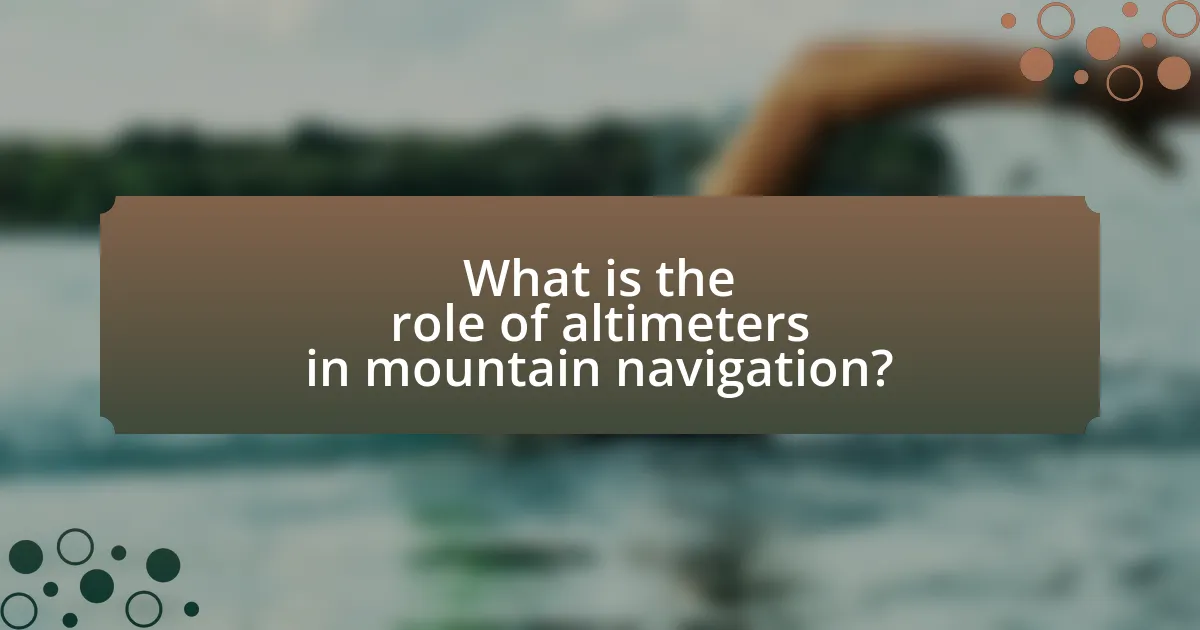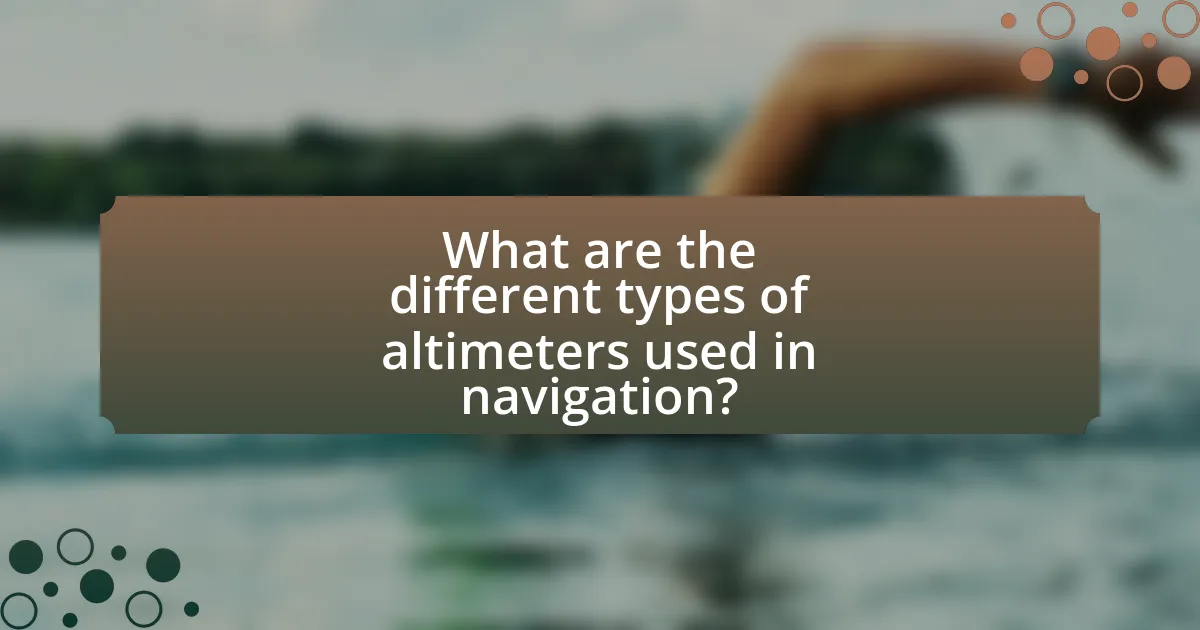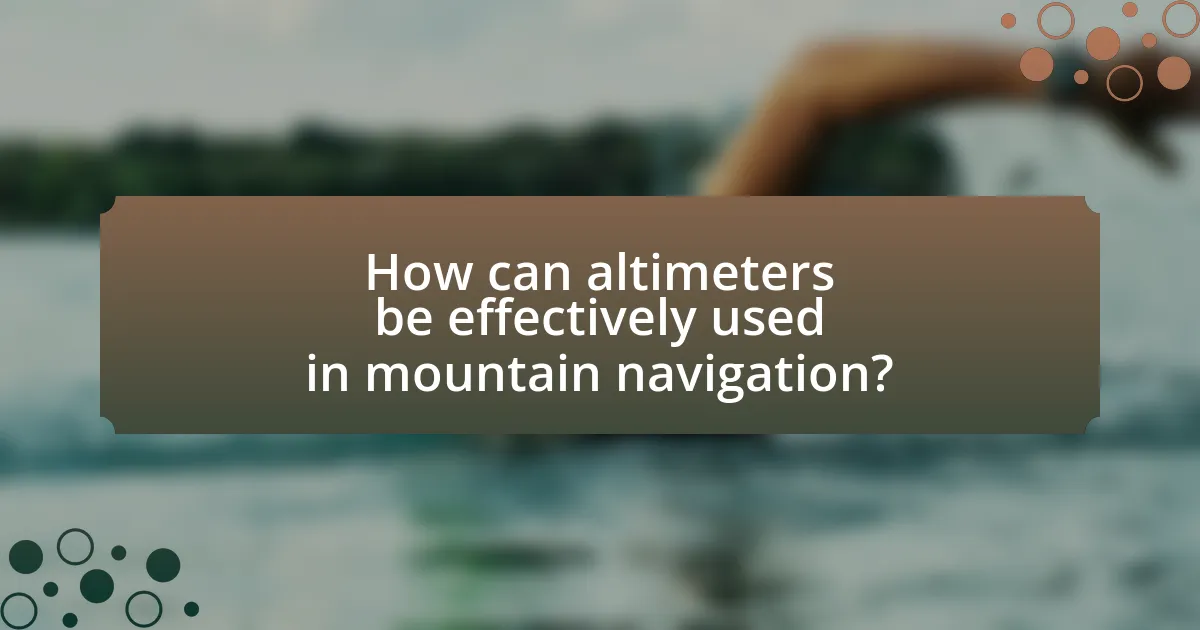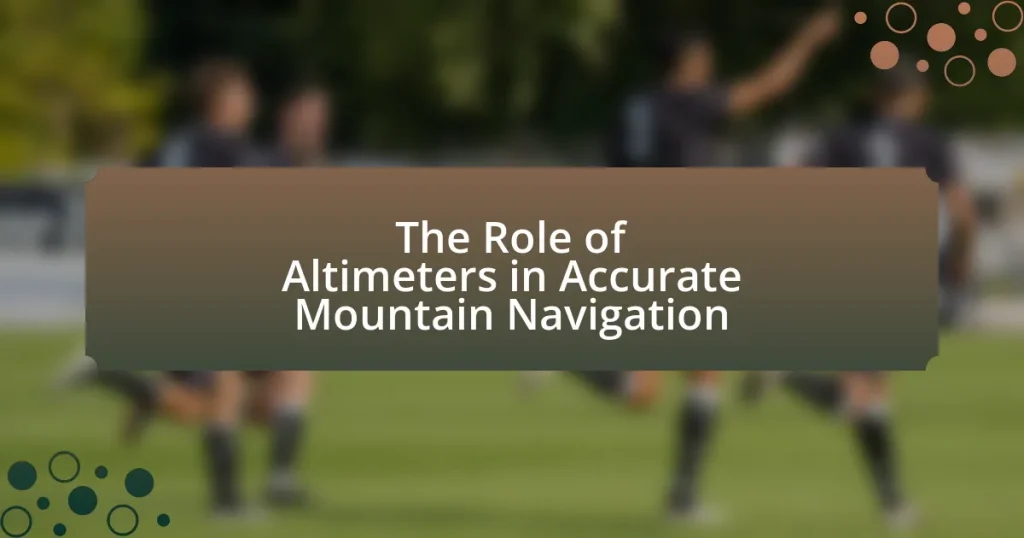Altimeters are essential tools in mountain navigation, providing accurate elevation readings that help users assess their altitude relative to sea level. This article explores the functioning of altimeters, including barometric and GPS types, and their significance in route planning and safety during outdoor activities. It discusses how atmospheric pressure affects altitude measurements, the risks associated with inaccurate readings, and best practices for effective use. Additionally, the article highlights the importance of combining altimeters with other navigation tools and understanding terrain to enhance safety and accuracy in mountainous environments.

What is the role of altimeters in mountain navigation?
Altimeters play a crucial role in mountain navigation by providing accurate elevation readings, which help users determine their altitude relative to sea level. This information is essential for route planning, assessing terrain difficulty, and ensuring safety in mountainous environments. For instance, knowing the altitude can assist climbers in avoiding altitude sickness and navigating challenging weather conditions, as certain elevations may present increased risks. Additionally, altimeters can help hikers track their ascent and descent, allowing for better management of energy and time during treks.
How do altimeters measure altitude?
Altimeters measure altitude by detecting changes in atmospheric pressure. As altitude increases, atmospheric pressure decreases, allowing altimeters to calculate elevation based on this pressure difference. Specifically, barometric altimeters use a pressure sensor to measure the current air pressure and compare it to a standard reference pressure at sea level, which is approximately 1013.25 hPa. This relationship is governed by the barometric formula, which provides a mathematical model for converting pressure readings into altitude measurements.
What types of altimeters are commonly used in mountain navigation?
The types of altimeters commonly used in mountain navigation are barometric altimeters and GPS altimeters. Barometric altimeters measure altitude based on atmospheric pressure changes, providing accurate readings in stable weather conditions. GPS altimeters, on the other hand, utilize satellite signals to determine altitude, offering reliable data even in variable weather but can be less precise in areas with poor satellite visibility. Both types are essential for effective navigation in mountainous terrain, as they help climbers and hikers assess elevation changes and plan routes accordingly.
How does atmospheric pressure affect altimeter readings?
Atmospheric pressure directly affects altimeter readings by determining the altitude measurement based on the pressure changes in the atmosphere. Altimeters function by measuring the ambient air pressure and comparing it to a standard atmospheric pressure at sea level, which is typically 1013.25 hPa (hectopascals). When atmospheric pressure decreases, indicating an increase in altitude, the altimeter will register a higher altitude. Conversely, an increase in atmospheric pressure suggests a lower altitude. This relationship is grounded in the barometric formula, which describes how pressure decreases with altitude in the atmosphere. Therefore, accurate altimeter readings rely on real-time atmospheric pressure data to ensure precise altitude measurements, essential for safe navigation in mountainous terrains.
Why are altimeters essential for mountain navigation?
Altimeters are essential for mountain navigation because they provide critical information about elevation, which is vital for route planning and safety. Accurate elevation data helps climbers and hikers assess terrain features, identify potential hazards, and determine their position relative to topographic maps. For instance, a study published in the Journal of Outdoor Recreation and Tourism highlights that using altimeters can significantly reduce the risk of altitude sickness by allowing users to monitor their ascent rate and adjust accordingly.
What risks are associated with inaccurate altitude readings?
Inaccurate altitude readings pose significant risks, including navigation errors, increased likelihood of accidents, and potential for life-threatening situations. For instance, a mountaineer relying on faulty altitude data may misjudge their position, leading to unintended descents into hazardous terrain or failure to reach safe zones. Historical incidents, such as the 1996 Mount Everest disaster, illustrate how altitude miscalculations can contribute to fatal outcomes, as climbers underestimated their elevation and faced severe weather conditions. Additionally, inaccurate readings can hinder search and rescue operations, complicating efforts to locate individuals in distress.
How do altimeters enhance safety during mountain expeditions?
Altimeters enhance safety during mountain expeditions by providing accurate elevation readings, which help climbers monitor their altitude and avoid hazards such as altitude sickness. By continuously tracking changes in elevation, altimeters enable users to maintain awareness of their ascent or descent, ensuring they stay within safe altitude limits. For instance, the risk of altitude sickness increases significantly above 2,500 meters, and having precise altitude data allows climbers to make informed decisions about pacing and acclimatization. Additionally, altimeters can assist in navigation by correlating altitude with topographical maps, helping climbers identify their location and plan safe routes.

What are the different types of altimeters used in navigation?
The different types of altimeters used in navigation include barometric altimeters, GPS altimeters, and radar altimeters. Barometric altimeters measure altitude based on atmospheric pressure changes, which is effective in varying weather conditions. GPS altimeters utilize satellite signals to determine altitude, providing accurate readings regardless of weather but dependent on satellite availability. Radar altimeters use radio waves to measure the distance to the ground, commonly used in aviation for precise altitude readings during landing. Each type serves specific navigation needs, ensuring accurate altitude measurement in various environments.
How do barometric altimeters work?
Barometric altimeters work by measuring atmospheric pressure to determine altitude. As altitude increases, atmospheric pressure decreases; this relationship allows the altimeter to calculate elevation changes based on pressure readings. The altimeter typically uses a barometric sensor that detects changes in pressure, which are then converted into altitude readings using the barometric formula. This method is validated by the standard atmospheric model, which states that pressure decreases exponentially with altitude, providing a reliable basis for altitude estimation in various conditions.
What are the advantages and disadvantages of barometric altimeters?
Barometric altimeters provide accurate altitude readings based on atmospheric pressure changes, making them advantageous for precise elevation measurements in mountain navigation. They are particularly effective in stable weather conditions, where pressure changes correlate closely with altitude changes, allowing for reliable tracking of ascent and descent.
However, barometric altimeters have disadvantages, including susceptibility to weather changes, which can lead to inaccurate readings if atmospheric pressure fluctuates due to weather systems. Additionally, they require calibration to a known altitude to maintain accuracy, and failure to do so can result in significant errors in altitude readings.
In what situations are barometric altimeters most effective?
Barometric altimeters are most effective in stable weather conditions where atmospheric pressure remains relatively constant. In these situations, the altimeter can accurately measure altitude changes based on the pressure variations associated with elevation. For example, during clear days in mountainous regions, the consistent pressure allows for reliable altitude readings, which is crucial for navigation and safety in outdoor activities like hiking and climbing. Studies have shown that barometric altimeters can provide accurate altitude measurements within a few meters when atmospheric conditions are stable, making them essential tools for mountaineers and pilots.
What is the function of GPS altimeters?
GPS altimeters function to determine the altitude of a location by using signals from satellites. They calculate the distance to multiple satellites and apply trilateration to ascertain the user’s elevation above sea level. This technology is crucial for accurate navigation in mountainous terrains, where precise altitude information is essential for safety and route planning. GPS altimeters provide real-time altitude data, which is vital for hikers, climbers, and pilots to avoid hazards and make informed decisions during their activities.
How do GPS altimeters differ from barometric altimeters?
GPS altimeters determine altitude by calculating the distance between the device and satellites, while barometric altimeters measure altitude based on atmospheric pressure changes. GPS altimeters provide absolute altitude data, which can be less affected by weather conditions, whereas barometric altimeters are influenced by local weather patterns and require calibration to sea level pressure for accuracy. This distinction is crucial for mountain navigation, as GPS altimeters can maintain accuracy in varying weather, while barometric altimeters may give misleading readings during rapid weather changes.
What are the limitations of GPS altimeters in mountain navigation?
GPS altimeters have limitations in mountain navigation primarily due to their reliance on satellite signals, which can be obstructed by terrain features such as mountains and dense forests. This obstruction can lead to inaccurate altitude readings, as GPS systems may struggle to acquire a clear line of sight to multiple satellites. Additionally, GPS altimeters can be affected by atmospheric conditions, such as ionospheric delays, which can further distort altitude measurements. Studies have shown that in mountainous regions, the accuracy of GPS altitude data can vary significantly, often resulting in errors of several meters, which is critical in navigation where precise elevation information is essential for safety and route planning.

How can altimeters be effectively used in mountain navigation?
Altimeters can be effectively used in mountain navigation by providing precise elevation data, which helps hikers and climbers determine their altitude relative to sea level and navigate terrain accurately. By regularly checking the altimeter, users can track their ascent or descent, identify landmarks, and ensure they are on the correct path, especially in areas where trails may not be clearly marked. Studies show that accurate altitude readings can significantly enhance route planning and safety, as elevation changes often correlate with weather conditions and potential hazards in mountainous regions.
What best practices should be followed when using altimeters?
When using altimeters, it is essential to calibrate them regularly to ensure accurate readings. Calibration should be performed at known reference points, such as sea level or a specific elevation, to account for atmospheric pressure changes that can affect altitude measurements. Additionally, users should consistently monitor weather conditions, as fluctuations in barometric pressure can lead to inaccurate altitude readings. It is also advisable to maintain a record of altitude changes during navigation to identify any discrepancies and adjust accordingly. Following these practices enhances the reliability of altimeter data, which is crucial for safe and effective mountain navigation.
How can users calibrate their altimeters for accurate readings?
Users can calibrate their altimeters for accurate readings by adjusting the device to the current atmospheric pressure at sea level. This adjustment is crucial because altimeters measure altitude based on changes in air pressure, which can vary with weather conditions. To calibrate, users should obtain the local barometric pressure from a reliable source, such as a weather station or a smartphone app, and input this value into the altimeter. This process ensures that the altimeter provides precise altitude readings, which is essential for safe navigation in mountainous terrain.
What common mistakes should be avoided when using altimeters?
Common mistakes to avoid when using altimeters include failing to calibrate the device before use, which can lead to inaccurate altitude readings. Users should always set the altimeter to the correct reference pressure at the start of their journey, as atmospheric pressure changes can significantly affect readings. Additionally, neglecting to adjust for weather changes, such as pressure drops due to storms, can result in misleading altitude information. Another mistake is relying solely on the altimeter without cross-referencing with other navigation tools, which can lead to errors in navigation. Lastly, not regularly checking the altimeter during the journey can cause discrepancies in altitude awareness, especially in mountainous terrain where elevation changes rapidly.
What tips can improve navigation accuracy with altimeters?
To improve navigation accuracy with altimeters, calibrate the altimeter regularly to ensure it reflects current atmospheric pressure. Regular calibration is essential because altimeters measure altitude based on air pressure, which can vary with weather changes. Additionally, using a known reference point, such as a topographic map or GPS coordinates, can enhance accuracy by providing a baseline for comparison. Studies indicate that discrepancies in altitude readings can be minimized by cross-referencing altimeter data with these reliable sources, thus ensuring more precise navigation in mountainous terrains.
How can combining altimeters with other navigation tools enhance safety?
Combining altimeters with other navigation tools enhances safety by providing comprehensive situational awareness and improving decision-making in mountainous terrains. Altimeters measure altitude, which is crucial for understanding elevation changes, while tools like GPS and compasses offer positional data and directional guidance. This integration allows for cross-verification of information; for instance, if an altimeter indicates a sudden drop in altitude, GPS can confirm the location and help identify potential hazards such as cliffs or steep descents. Studies have shown that using multiple navigation tools reduces the likelihood of navigation errors, which can lead to accidents in challenging environments.
What role does terrain knowledge play in using altimeters effectively?
Terrain knowledge is crucial for using altimeters effectively because it allows users to interpret altitude readings in the context of the surrounding landscape. Understanding the terrain helps users recognize features such as peaks, valleys, and slopes, which can influence altimeter accuracy due to factors like atmospheric pressure changes and local topography. For instance, in mountainous regions, knowing the elevation of surrounding peaks enables users to adjust their altimeter settings for more precise navigation, as altimeters can be affected by weather conditions and temperature variations. This contextual awareness enhances the reliability of altitude data, ensuring safer and more accurate navigation in challenging environments.
